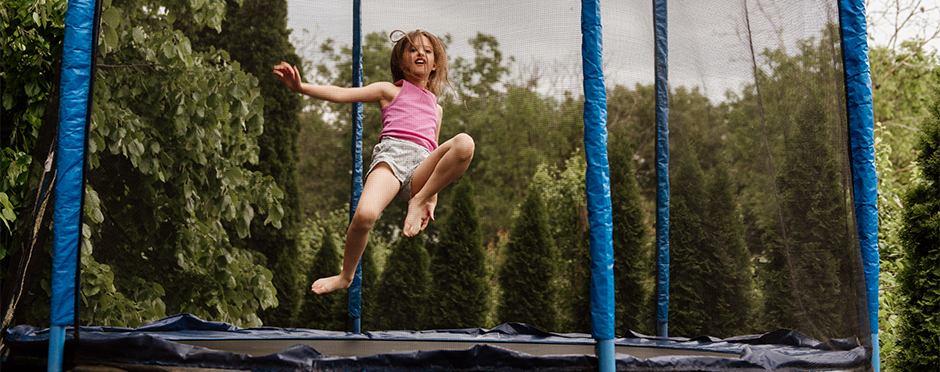
Trampolines: For Sport And Fun
Leave a CommentTrampolines are commonly found in backyards, and the popularity of jump parks has also increased in recent years. Did you know that there is also a sport for a competitive trampoline? In fact, it’s an Olympic sport!
Differences Between Competition Trampoline and Recreation
- The material used on backyard trampolines differs from those used on competition trampolines.
- The springs used are also different. Higher quality springs are used on competition trampolines
- Both the material and the springs affect the amount of spring and tension for the trampoline
- Competitive trampolines allow the athlete to jump higher and safely perform double and triple rotations that would not be achieved safely on a backyard trampoline.
- Competition trampolines have a cross or marking in the center of the bed in a contrasting color that allows the athlete to guide where they land to keep them safer and in the middle of the trampoline.
- Competitive trampoline is a sport that is closely related to gymnastics. These athletes train and know how to land safely and safely fall with better control of their body and with better jumping mechanics.
- Spotters are required during a trampoline competition. There can be up to 6 spotters surrounding a trampoline athlete during competition. There are also mats surrounding the trampoline to help increase safety should the athlete land incorrectly.
- The sport of trampoline only has one athlete on a trampoline at a time. There are synchronized events, but the athletes are on neighboring trampolines placed next to each other rather than on the same one. Many backyard trampolines have multiple children jumping simultaneously; as many of us have experienced, one jumper’s recoil can impact the second jumper.
- Scoring in competition is based on the difficulty of the skill and the total seconds spent in the air. Deductions can occur for bad form or displacement from the center of the bed.
Causes Of Injury On Trampolines
- Falling onto the trampoline edge, frame, or springs
- Falling off the trampoline
- Stunts that go wrong or land improperly
- Collision with another jumper
Examples Of Injuries That Can Occur On Trampoline:
Whiplash Injury
Whiplash is a neck injury that occurs due to a rapid and forceful back-and-forth motion of the neck. Whiplash can occur several ways on a trampoline; a jumper can fall from the trampoline with a hit or jostle to the head, or two jumpers can collide, leading to a whiplash-type injury. Initial treatment for whiplash includes heat or ice and rest to manage the pain. Physical therapy is also beneficial after whiplash to help restore normal neck motion and strength to resume normal activities. Whiplash and concussions can co-occur, and a physical therapist can assess the needed treatment for both conditions.
Fractures
Fractures can occur on a trampoline from a fall or from landing incorrectly. Fracture incidence increases with more jumpers on a trampoline at one time. In young children, there is a specific fracture referred to as a “trampoline fracture” in the tibia bone, just below the knee. This type of fracture occurs when a larger or heavier jumper causes the surface to recoil upward while the child is descending, which leads to an excessive load on the tibia2. Although this type of fracture is not common, they do occur, and for safety reasons, fewer jumpers on a trampoline is recommended to decrease the risk of this injury.
Soft Tissue Tears
The “soft tissues” of the body encompass your tendons, muscles, and ligaments. Injury on trampolines can include ankle or wrist sprains or injury to the knee in the form of an ACL sprain or tear. The type of injury is mainly dependent on how the injury occurs. A poor landing may cause a twist in the ankle or knee. A fall from the trampoline may result in landing on the arm and injuring the wrist or shoulder. These types of injuries are commonly accompanied by swelling, difficulty moving the joint, decreased range of motion, and pain. A visit to a doctor’s office or a physical therapist can help plan the best recovery based on the injury.
Don’t Let An Activity You Love Put You At Risk For Injury
Trampolines are a fun activity for kids and more serious athletes for competition. Ensure you follow precautions as best you can to help ensure safety while jumping. Should an injury occur, find your closest Athletico location for a free injury assessment.
*Per federal guidelines, beneficiaries of plans such as Medicare, Medicaid, Tricare, VHA and other federally funded plans are not eligible for free assessments.
The Athletico blog is an educational resource written by Athletico employees. Athletico bloggers are licensed professionals who abide by the code of ethics outlined by their respective professional associations. The content published in blog posts represents the opinion of the individual author based on their expertise and experience. The content provided in this blog is for informational purposes only, does not constitute medical advice and should not be relied on for making personal health decisions.
References:
1. https://www.gymnastics.sport/site/pages/disciplines/app-tra.php
2. Jääskelä M, Kuivalainen L, Victorzon S, Serlo W, Lempainen L, Sinikumpu JJ. Trampoline-related proximal tibia impaction fractures in children: a population-based approach to epidemiology and radiographic findings between 2006 and 2017. J Child Orthop. 2020 Apr 1;14(2):125-131. doi: 10.1302/1863-2548.14.190177. PMID: 32351625; PMCID: PMC7184643.
